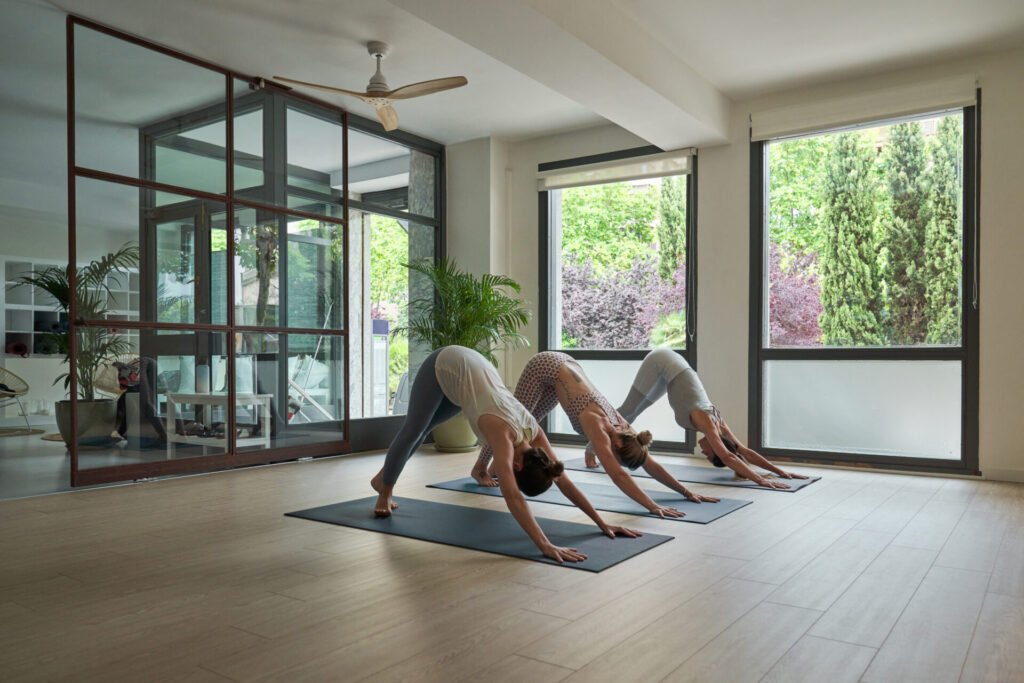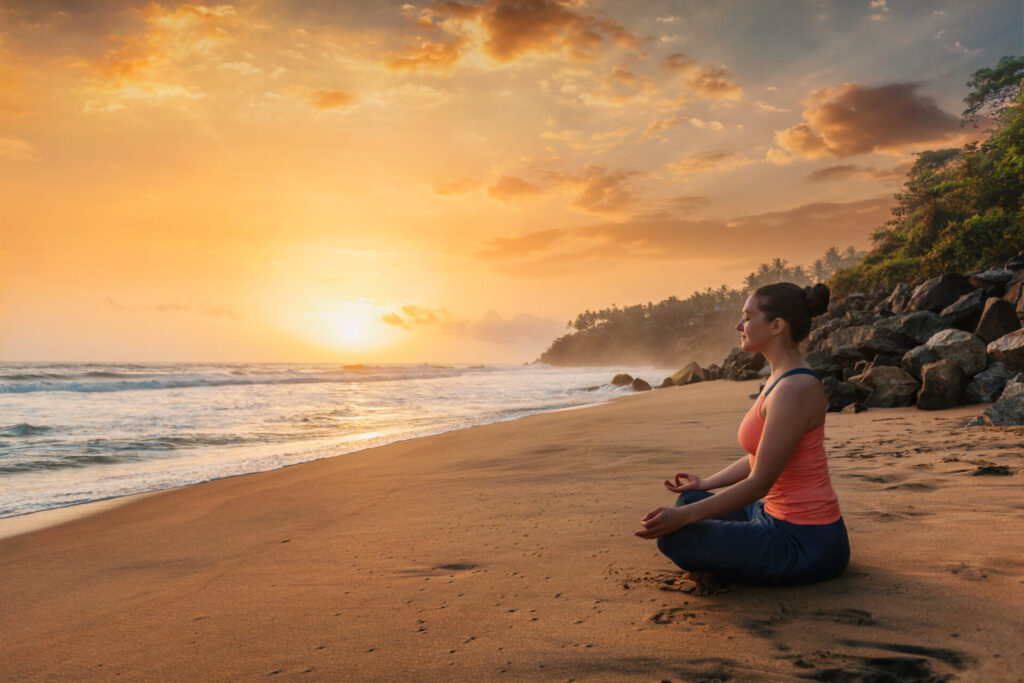Integral Yoga, often described as a path to holistic well-being and spiritual awakening, is like a compass guiding us through the journey of life.
In this blog post, we’ll embark on a journey to demystify Integral Yoga and understand its profound significance.
Imagine Integral Yoga as a roadmap that helps you navigate not just the outer world but also the depths of your own mind and spirit.
It’s about achieving a harmonious union of your mind, body, and spirit, all while living in a world filled with distractions and demands.
This guide aims to make Integral Yoga accessible and relatable, whether you’re a seasoned practitioner or someone who’s just curious about this ancient practice.
So, let’s dive in and uncover the wisdom, practices, and transformative power of Integral Yoga together.
Whether you’re seeking physical health, mental clarity, or a deeper connection with your inner self, Integral Yoga offers a pathway to explore and enrich your life.
What Is Integral Yoga?

Integral Yoga is like a powerful compass for your inner journey. Imagine it as a holistic path that brings together your body, mind, and spirit, helping you become the best version of yourself.
Founded by Sri Aurobindo and nurtured by The Mother (Mirra Alfassa), it’s not just about twisting your body into yoga poses but about finding a deeper connection within yourself and with the universe.
This unique approach to yoga focuses on weaving together various yogic methods, like meditation, breathing exercises, and self-reflection, into one seamless tapestry.
The ultimate goal? To transform your consciousness, to make you more aware, peaceful, and loving in every aspect of life.
So, Integral Yoga is not just about sweating on the yoga mat; it’s a profound journey towards self-discovery and spiritual growth, where every step brings you closer to your true self and the universal consciousness.
Historical Background Of Integral Yoga
Integral Yoga has its roots in the early 20th century, and it was shaped by some remarkable individuals.
One Sri Aurobindo and the Mother (Mirra Alfassa). Sri Aurobindo, a philosopher, poet, and spiritual leader from India, was the driving force behind the development of Integral Yoga.
In the early 20th century, he withdrew from the political world to focus on spiritual pursuits and sought to unite the physical, mental, and spiritual dimensions of human existence.
He believed in the idea that life should not be divided into the sacred and the secular but that every aspect of our existence could be a means for spiritual growth.
The Mother, often referred to as simply “the Mother,” was a collaborator and spiritual partner of Sri Aurobindo.
Originally from France, she joined Sri Aurobindo in India and played a pivotal role in establishing the Sri Aurobindo Ashram in Pondicherry, India.
Another significant figure in the history of Integral Yoga was Sri Swami Satchidananda, an esteemed yoga teacher who brought the teachings of yoga to the West in the 1960s.
He promoted the idea that yoga could be a path to both physical health and spiritual awakening, making it accessible to people in the West who were seeking ways to cope with the stresses of modern life.
His message of unity, peace, and the interconnection of all living beings resonated with many, and he became a respected leader in the yoga community.
In the United States, Sri Swami Satchidananda established Yogaville Ashram in Buckingham, Virginia, as a hub for Integral Yoga teachings and practices.
This ashram became a place of learning, retreat, and community for individuals seeking to delve deeper into Integral Yoga.
Together, they developed Integral Yoga as a comprehensive path to spiritual evolution and transformation.
Integral Yoga’s historical roots are intertwined with the lives and teachings of these visionaries, and their work has left a lasting impact on the spiritual landscape, emphasizing the synthesis of different yogic paths and the transformation of consciousness.
Core Principles Of Integral Yoga
Union Of The Physical, Mental, And Spiritual
In Integral Yoga, there’s a beautiful idea that our bodies, minds, and spirits are all connected like pieces of a puzzle. Imagine feeling strong physically, having a clear mind, and also feeling a deep sense of peace and purpose in your heart.
That’s what Integral Yoga aims for – to unite these aspects of our being so we can experience a more balanced and joyful life.
Synthesis Of Different Yogic Paths
Integral Yoga is like a grand fusion cuisine of yogic practices. It blends the wisdom of various yogic paths—Hatha Yoga, Bhakti Yoga, Karma Yoga, and others—into a comprehensive practice.
This way, you can draw from a rich tapestry of techniques and philosophies to enhance your personal journey without being confined to just one path.
Transformation Of Consciousness
This one’s like the magical part of Integral Yoga. It’s all about changing the way you see and experience the world. Imagine looking at the same painting, but suddenly you notice details and colors you never saw before.
In Integral Yoga, through practices like meditation and self-reflection, you can transform your consciousness. It’s like upgrading your perspective on life, making it more meaningful and full of love and understanding.
Integral Yoga Practices
Asana (Physical Postures)
In Integral Yoga, Asana is about the different yoga poses you practice. It’s not just about physical fitness but also keeping your body healthy and flexible. These poses help you sit still and be comfortable for meditation. Some common poses include:
Lotus Pose (Padmasana):

Sitting cross-legged with each foot on the opposite thigh promotes deep relaxation and meditation by aligning your spine and focusing your mind.
Downward Dog (Adho Mukha Svanasana):

Forming an inverted “V” shape with your body, this pose stretches your entire body, relieves tension, and improves flexibility.
Cobra Pose (Bhujangasana):

Lying face down, lifting your upper body while keeping your lower body on the ground, strengthens the back and opens the chest.
Child’s Pose (Balasana):

Kneeling with your buttocks on your heels and stretching your arms forward is a restful pose that helps relieve stress and gently stretches the back.
Mountain Pose (Tadasana):

Standing straight with your feet together, grounding yourself like a strong mountain, improves posture and cultivates a sense of stability and balance.
Pranayama (Breath Control)

Pranayama is all about controlling your breath. You learn how to breathe deeply and slowly. This helps to bring more energy into your body and calm your mind.
One simple practice is to inhale for a few seconds, hold your breath for a moment, and then exhale slowly. It’s like giving your body a refreshing energy boost.
Meditation And Mindfulness

Meditation is like giving your mind a break from the constant chatter. It’s about sitting quietly, focusing on your breath or a calming image, and finding inner peace.
Mindfulness is a bit like meditation but can be done while doing everyday activities. It’s about being fully present in the moment, whether you’re eating, walking, or just sitting. Both practices help you reduce stress, increase concentration, and find a sense of inner calm.
Study And Self-Inquiry
In Integral Yoga, studying and self-inquiry means exploring your inner self. You read and learn about the teachings of great spiritual leaders and texts.
You also ask deep questions about yourself, like “Who am I?” and “What’s my purpose?” This self-discovery helps you understand your true nature and connect with your inner wisdom. It’s like a journey of self-exploration and growth.
The Synthesis Of Life
Integral Living
Integral living is about bringing the principles of yoga into your everyday life. It’s like taking the calm and balance you find in yoga class and using it in your daily routines.
Imagine staying calm in stressful situations, making thoughtful choices, and being kind to others.
It’s about finding a balance between your work, family, and personal time, while always being mindful of your actions. Integral yoga incorporates these different yogic principles into everyday life.
Karma Yoga (Yoga Of Action)
Karma yoga is like doing good deeds without expecting anything in return. It’s about helping others selflessly, just because it’s the right thing to do.
Picture volunteering at a soup kitchen or helping a friend move without expecting a thank-you. In karma yoga, you learn that giving to others can bring happiness and fulfilment.
Bhakti Yoga (Yoga Of Devotion)
Bhakti yoga is all about love and devotion. It’s like having deep affection and love for something greater than yourself, like a higher power or the universe.
In this practice, you express your love and devotion through prayers, songs, or rituals. It’s a bit like singing a heartfelt song to express your feelings.
Jnana Yoga (Yoga Of Knowledge)
Jnana yoga is like using your brainpower to understand life’s mysteries. It’s about seeking wisdom and truth through study and self-reflection.
Imagine reading books, contemplating life’s big questions, and gaining knowledge to grow as a person. In jnana yoga, you explore your inner self and the world around you to find deeper understanding.
Hatha Yoga
Hatha yoga involves physical postures and breath control. It’s like a workout that helps you become strong and flexible, both in your body and mind.
Through yoga poses and controlled breathing, you improve your physical health while also calming your thoughts. It’s like doing exercises that benefit your whole being.
Raja Yoga
Raja yoga is about mastering your mind and emotions. It’s like becoming the king or queen of your thoughts. You learn to meditate and use mental discipline to achieve inner peace and focus.
Just like a ruler who leads with wisdom and control, in raja yoga, you become the ruler of your own mind.
Japa Yoga
Japa yoga involves repeating a mantra or a sacred word, like a peaceful chant. It’s like a soothing melody for your soul. By repeating these words with sincerity and devotion, you connect with your inner self and the divine.
It’s like finding comfort in the rhythm of words that lead you to a deeper sense of peace and spirituality.
The Benefits Of Integral Yoga
Physical Health And Well-Being
Integral Yoga helps improve your physical health and overall well-being. By practicing yoga postures (asanas) and breath control (pranayama), you can increase your flexibility, strength, and balance.
This not only helps prevent physical ailments but also boosts your energy levels, making you feel more vibrant and alive.
Regular practice can reduce stress, lower blood pressure, and enhance your immune system, which means you’re better equipped to face the challenges of daily life.
Mental Clarity And Emotional Balance
Integral Yoga isn’t just about physical health; it’s also a powerful tool for sharpening your mind and achieving emotional balance.
Through meditation and mindfulness practices, you can gain better control over your thoughts and emotions. This means less mental clutter and more clarity in your decision-making.
It helps you manage stress, anxiety, and even depression more effectively, allowing you to experience inner peace and emotional stability.
Spiritual Growth And Transformation
One of the remarkable aspects of Integral Yoga is its capacity to facilitate spiritual growth and inner transformation.
As you delve deeper into your yoga practice, you’ll begin to experience a profound sense of connection with something greater than yourself.
This spiritual awakening can lead to a greater understanding of your purpose in life and a sense of inner fulfilment. It’s like uncovering your true self and finding a deeper sense of meaning and contentment.
Connection With The Universal Consciousness
Integral Yoga teaches you to connect with the universal consciousness or the divine, whatever that means to you. It’s a journey of self-discovery that goes beyond the physical and mental realms.
Through practices like devotion (bhakti) and self-inquiry (jnana), you can experience a sense of oneness with the universe.
This connection brings a profound sense of peace, love, and unity, making you feel like an integral part of the grand tapestry of life. It’s a truly transformative experience that can enrich your life in countless ways.
Final Thoughts
In wrapping up our journey through Integral Yoga, it’s like reaching the finish line of a long race. Integral Yoga isn’t just about stretching and breathing – it’s a path that leads to a more balanced, peaceful, and fulfilling life.
It’s a journey that starts with understanding ourselves better and then combining different yoga practices like meditation, physical postures, and breathing techniques to become more harmonious.
By practicing Integral Yoga, we can not only improve our physical health but also sharpen our minds, find inner peace, and connect with something bigger than ourselves – call it the universe, the divine, or just pure happiness. Remember, this is a path you can take at your own pace, and there’s no need to rush.
So, if you’re thinking about starting or deepening your Integral Yoga practice, know that it’s a wonderful choice that can positively impact your life in more ways than you can imagine.













